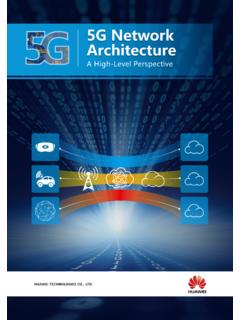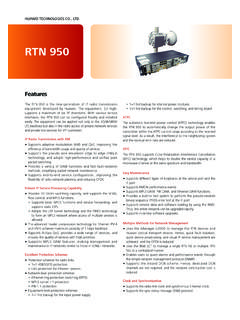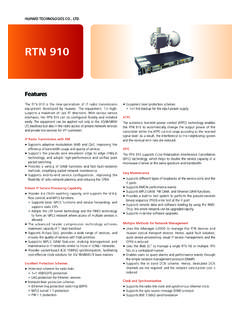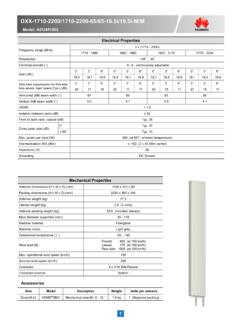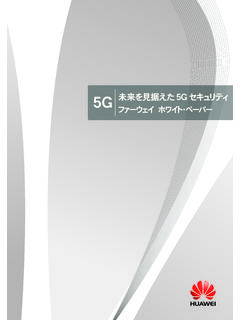Transcription of Small Cell Network White Paper - huawei.com
1 Small Cell Network White PaperNovember 2016A GSA White Paper with input from Ericsson and HuaweiCopyright GSA Global mobile Suppliers Association 2016 Table of contents1. 2. 3. 4. 5. 6. 7. Digitalization to Drive MBB Networks Require Small Cell Digital Challenge of Indoor Digitalization to Digital Indoor Network Operations & Maintenance (O&M)..03 Digital Small Cells Small for Integrated Small performing and Consistent User Network and Orchestrated Network Small Cells User Network Process of Building in Unlicensed Drive to Use Unlicensed spectrum Spectrum Tech Small Cell architecture , Towards 5G RAN meet Operator s evolution of Cloud-based of Cloud-based Cell Solution1.
2 ForwardAs Society enters the 4th Industrial Revolution the migration to cyber-physical systems digitalisation and ubiquitous mobile connectivity will result in a re-engineering of many industries. There will be substantial shifts on the demand and supply sides of these industries due partially from increased transparency of business processes and alternative engagements with customers due to new patterns of consumer behaviour. These shifts in many cases are built upon access to mobile networks and data and are compelling companies to modify how they design, market, and deliver products and wireless industry will also need to evolve as mobile connectivity expands to address multiple use cases from wireless sensors to robotics and autonomous transportation.
3 Mobile operators will therefore need to grow their networks using creative Network design techniques as well as advancements that are being made in new radio exponential growth in data traffic and the billions of predicted connected things means operators will have to consider alternative mobile Network architectures to deliver more coverage and more capacity, at the right time and in the right places. The deployment of Small Cells as part of a mobile operator s overall coverage and capacity strategy therefore makes economic sense. Capacity can be targeted to where the demand is and in-building coverage is easier to plan, deploy and availability and reach of mobile services will eventually expand into all corners of the world and deliver a ubiquitous service, 24/7, helping operators address new business areas and business models for a broader and more diverse and discerning customer base.
4 Small Cells will be a core part of those Barrett PresidentGlobal mobile Suppliers Association2. PrefaceIn today s society, Mobile Broadband (MBB) is fully connected to our everyday lives and routines. Since the early part of this century, MBB has developed dramatically, significantly improving pre-existing networks and structures and has helped create our modern society. The propagation of MBB services continues and is evolving as the mobile industry develops new technologies to meet the current and future needs of customers. As indicated by the figure 1, MBB services will continue to grow as demands for mobiles data traffic intensifies.
5 We are already seeing significant changes in our way of life through the effects of mobile music, mobile video and mobile payment. While the development of MBB has improved dramatically, new requirements for MBB networks will continuously arise, such as ubiquitous coverage, ultra-wide bandwidth, ultra-high capacity and the support for flexible & compatible 1 compares the global mobile traffic patterns of 2015 with the projected patterns of 2021. It suggests MBB services are likely to grow dramatically through use of user equipment (UE), especially the adoption of cells are likely to play an important role in meeting the Network demands of the future.
6 The increasing numbers of massive hotspot areas with demanding capacity and connections requirements has seen a rise in popularity of Small cell solutions. Over the past 3 to 5 years, operators, who invested 0201520212015202120152021201520212015202 1510152025 NorthAmericaLatinAmericaWesternEuropeCen tral Europeand MEAAsia PacificMobile PCs, tablets andmobile routersSmartphones13 XThere will be 13x mobiledata traffic in CentralEurope and Middle Eastand Africa up to 2021 Figure 1: Global mobile data traffic (monthly Exabyte) [1]02 Small Cell Solutionheavily on Small cells in hotspot areas to improve user experience, have profited from Small cell deployment.
7 Small Cells will assume a key role in future MBB development because the mobile industry, regulators and institutions are evaluating spectrum resources above 6 GHz which will result in reduced base station coverage. Similarly, digital services are crucial to the current and future development of MBB services. Traditional Network deployment is increasingly being replaced by digital to forecasts from Small Cell forum [2], the global shipment of Small cells will reach tens of millions by believe operators need to address the following 4 areas to be successful in the future: 1. How to deal with the challenges from indoor areas, which will generate over 80% of the traffic?
8 2. How to build an integrated Network with Small Cells to meet mobile data demand and expected service performance?3. How to make full use of unlicensed spectrum resource to improve user experiences?4. How to develop a flexible Small Cell Network architecture to smoothly evolve towards 5G networks?[1] Source: Ericsson mobility report, June 2016[2] Source: Crossing the Chasm: Small Cells Industry November 2015, Small Cell Forum3. Indoor Digitalization to Drive MBB Indoor Networks Require Small Cell Digital SolutionsIndoor areas have already been high-value markets for many telecom operators.
9 With accelerating urbanization in developing countries, in-depth coverage in urban areas is increasingly complex and Network deployment to meet MBB data capacity growth is increasingly difficult. The traditional analogue indoor coverage solution - Distributed Antenna System (DAS) is unable to support 4G and 5G era requirements. However, digital Small Cells can provide full connectivity for all indoor scenarios. In particular, mobile traffic is necessary for ultra-dense areas such as sports stadiums, urban avenues, shopping mall, big transport hubs, etc. The Challenge of Indoor Digitalization NetworkAs a traditional indoor coverage solution, DAS can only meet the demands of 2G/3G era voice and mid-to-low-speed data services.
10 With the surge in indoor MBB requirements in the 4G era, DAS has become a restriction for indoor MBB due to the lack of Network capacity, scalability and poor evolution potential; limiting demand for subscriber surge in mobile data is depleting spectral resources, leading to the use of high frequency bands, including GHz, GHz, GHz, GHz, and even unlicensed 5 GHz spectrum. Although these bands are now the mainstream in MBB Network construction, they re not suitable for DAS, which suffers high transmission loss in high-frequency bands through DAS coaxial feeds. High-frequency spectrum is reducing the efficiency of the outside-in model, where indoor traffic depends on outdoor macro Network absorption because it increases building penetration losses in outdoor macro speed in wireless standards has increased rapidly.
